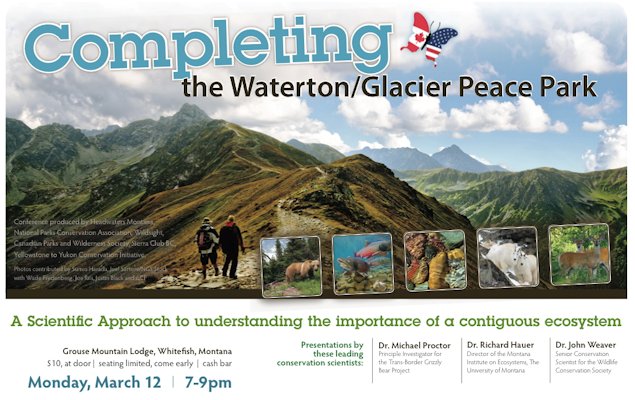(Note: This is the full text of a public letter signed by six former superintendents of Waterton and Glacier Parks encouraging the U.S. and Canadian governments to complete passage of legislation intended to enhance protections for the parks, including the U.S. North Flathead Protection Act currently stuck in a year-end Senate logjam.)
One hundred years ago the United States followed Canadaʼs leadership in protecting the core of the Crown of the Continent ecosystem, establishing Glacier National Park in Montana as a southern sister to Albertaʼs Waterton Lakes National Park. Waterton-Glacier International Peace Park is located where the Rocky Mountains tie our two countries into one landscape. As one of North Americaʼs most spectacular mountain parks, it is a source not only of inspiration and recreation, but also abundant clean water for communities from Hudson Bay to the Gulf of Mexico.
The combined parks encompass a protected topography of 1.1 million acres (450,000 hectares) that has gifted generations with an inheritance beyond measure. Today, more than 2 million people from around the world travel to Waterton-Glacier annually to experience the alpine majesty of the worldʼs first international peace park.
Throughout this past century, Canada and the United States have taken significant steps to protect and preserve this international treasure, including bilateral support for designating the Peace Park a World Heritage site in 1995. Early in this centennial birthday year, both countries furthered a decades-old international effort to safeguard Waterton-Glacierʼs pristine headwaters, by protecting British Columbiaʼs remote Flathead River Valley and Montanaʼs North Fork Flathead River drainage from proposed coal strip-mining, coalbed methane extraction, and gold mines.
The steps taken to date — which include retiring more than 200,000 acres (80,000 hectares) of oil and gas leases in the Montana North Fork, and a mining ban in the B.C. portion of the watershed — are historic and worthy of recognition. However, there remains unfinished work to ensure the legacy of Waterton-Glacier.
Nearly six months ago, on the margins of the G-20 Summit in Toronto, the offices of the Prime Minister and President issued a joint statement pledging federal action toward the sustained protection of Waterton-Glacierʼs transboundary headwaters. This commitment will build upon an agreement between the province of British Columbia and state of Montana — signed during the 2010 Vancouver Winter Olympics — to enhance environmental protection and cooperation throughout the Crown of the Continent region. Today, however, the federal-to-federal agreement that will complete this state/provincial effort has yet to be accomplished.
In Canada, a long-standing proposal to complete the Peace Park by expanding Waterton Lakes National Park into one-third of British Columbiaʼs Flathead Valley remains under government review, despite strong public support at the local, regional and national levels. And earlier this year, the UNESCO World Heritage Committee urged Canada to “develop a pro-active plan for enhancing wildlife connectivity” between Waterton-Glacier and Banff National Park, a step that remains incomplete.
Work also remains unfinished in Washington, D.C. Despite passing the U.S. Senate Natural Resources Committee nearly eight months ago, the bipartisan North Fork Protection Act has yet to be acted upon by the full Senate.
This vital legislation would prohibit new mining and fossil fuel leasing on Waterton-Glacierʼs western periphery, in high mountain country that includes the drinking water supply for the gateway community of Whitefish, Montana. The bill also protects lands throughout the Middle Fork of the Flathead River corridor, a Congressionally designated Wild and Scenic River that forms Glacier Parkʼs southwestern boundary. The measure enjoys tremendous local support, and represents a long-term and tangible gift for Glacier on its 100th birthday.
Today, however, this legislation remains stalled in the U.S. Congress. And without immediate action, this valuable and worthy endowment to future park visitors will be forced to begin the political process anew in 2011.
If we have learned one thing during these past 100 years, it is that international cooperation is a requisite to protecting a peace park that transcends boundaries. We urge leaders in both countries to ensure Waterton-Glacierʼs continued legacy through the prompt consideration and passage of these measures.
Word Count: 621
Contact Mick Holm: 406-756-9055 or mpholm@centurytel.net
Waterton Lakes Signatories
Merv Syroteuk, Creston, BC (1992-1996)
Peter Lamb, Lethbridge, AB (1999-2004)
Glacier National Park Signatories
Mick Holm, Columbia Falls, MT (2002-2008)
Dave A. Mihalic, Missoula, MT (1994-1999)
Gil Lusk, Green Valley, AZ (1986-1994)
Bob Haraden, Bozeman, MT (1980-1986)
Phil Iverson, Lakeside, MT (1974-80)
Bill J. Briggle, South Beach, OR (1969-1974)
